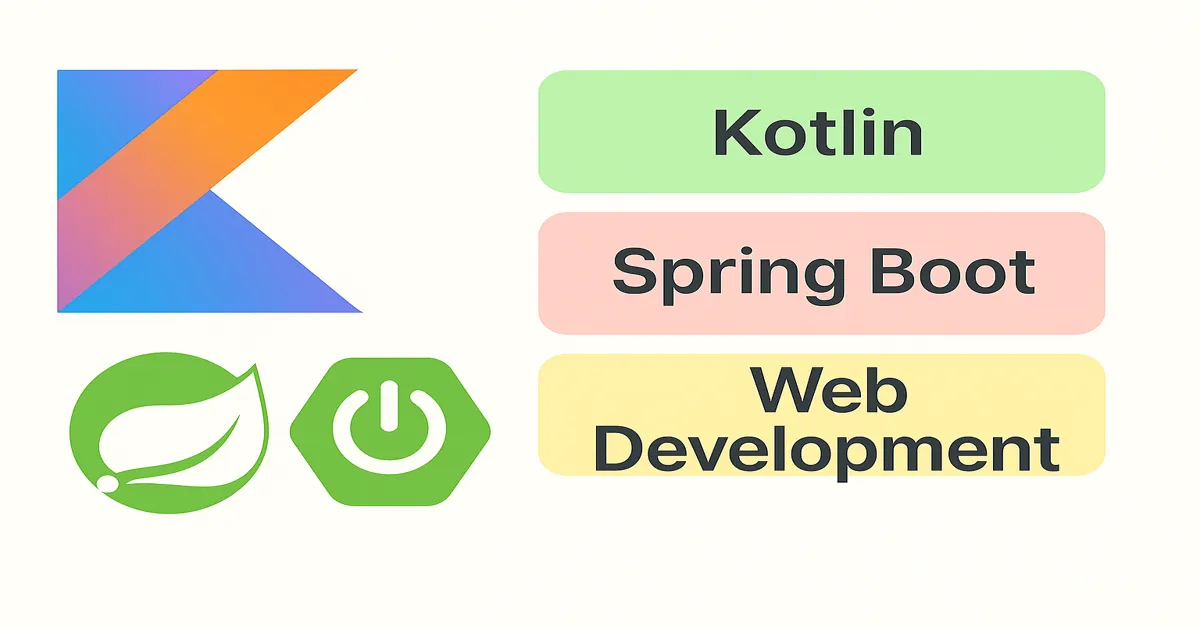In the evolving landscape of software development, productivity has become a key driver of technology adoption. Developers and companies alike are seeking tools that not only accelerate delivery timelines but also promote cleaner, more maintainable code. Enter Kotlin and Spring Boot—two technologies that together redefine the experience of building robust web applications.
While Spring Boot has long been the go-to framework for Java developers, Kotlin is rapidly becoming the language of choice for modern backend development. In 2025, their synergy is hard to ignore. This article unpacks the productive power of Spring Boot combined with Kotlin, examining how they enhance developer experience, improve code quality, and scale across projects of varying complexity.
Why Kotlin for Web Development?
Kotlin, developed by JetBrains, is a modern programming language that runs on the Java Virtual Machine (JVM). Though it gained popularity through Android development, its capabilities extend well beyond mobile. Kotlin brings expressive syntax, null safety, coroutines, and strong type inference to the JVM ecosystem.
Key Features That Drive Productivity:
- Concise Syntax: Write less code to achieve more.
- Null Safety: Eliminates entire categories of runtime errors.
- Interoperability: 100% compatible with existing Java libraries.
- Data Classes and Extension Functions: Simplify common programming patterns.
- Coroutines: Built-in support for asynchronous programming.
These features make Kotlin a natural fit for modern web development.
Spring Boot: The Foundation for Scalable Web Apps
Spring Boot is a powerful framework that simplifies Spring-based Java application development. It auto-configures most of the plumbing required for enterprise applications, letting developers focus on core functionality.
What Makes Spring Boot Stand Out:
- Opinionated Defaults: Reduces configuration overhead.
- Embedded Servers: No need for external Tomcat or Jetty setups.
- Extensive Ecosystem: Seamless integration with Spring Data, Security, Batch, etc.
- Production Readiness: Metrics, health checks, and monitoring tools included.
By pairing Spring Boot with Kotlin, developers gain not only a productive environment but also a resilient backend foundation.
Setting Up a Kotlin + Spring Boot Project
Let’s walk through setting up a Kotlin-powered Spring Boot application, highlighting the productivity boosts at each step.
1. Project Initialization
Use start.spring.io to generate a Kotlin project:
- Language: Kotlin
- Dependencies: Spring Web, Spring Data JPA, H2 Database, Spring Boot DevTools
2. Gradle Configuration (Kotlin DSL)
plugins {
kotlin("jvm") version "1.9.0"
kotlin("plugin.spring") version "1.9.0"
id("org.springframework.boot") version "3.1.0"
id("io.spring.dependency-management") version "1.1.0"
}
dependencies {
implementation("org.springframework.boot:spring-boot-starter-web")
implementation("org.springframework.boot:spring-boot-starter-data-jpa")
implementation("com.h2database:h2")
implementation("org.jetbrains.kotlin:kotlin-reflect")
testImplementation("org.springframework.boot:spring-boot-starter-test")
}Writing a REST API with Kotlin and Spring Boot
Let’s build a simple API for managing Product entities.
1. Define the Data Class
import jakarta.persistence.*
@Entity
data class Product(
@Id @GeneratedValue(strategy = GenerationType.IDENTITY)
val id: Long = 0,
val name: String,
val price: Double
)2. Create the Repository
import org.springframework.data.jpa.repository.JpaRepository
interface ProductRepository : JpaRepository<Product, Long>3. Build the Service Layer
import org.springframework.stereotype.Service
@Service
class ProductService(private val repository: ProductRepository) {
fun getAll(): List<Product> = repository.findAll()
fun getById(id: Long): Product = repository.findById(id).orElseThrow()
fun create(product: Product): Product = repository.save(product)
fun delete(id: Long) = repository.deleteById(id)
}4. Define the REST Controller
import org.springframework.web.bind.annotation.*
@RestController
@RequestMapping("/products")
class ProductController(private val service: ProductService) {
@GetMapping
fun all() = service.getAll()
@GetMapping("/{id}")
fun get(@PathVariable id: Long) = service.getById(id)
@PostMapping
fun create(@RequestBody product: Product) = service.create(product)
@DeleteMapping("/{id}")
fun delete(@PathVariable id: Long) = service.delete(id)
}How Kotlin Improves Spring Boot Development
Concise Syntax
Kotlin’s ability to reduce boilerplate dramatically improves code clarity. With data classes and type inference, a single line can express what Java would need several lines for.
Safer Code
Null safety is enforced at compile time, reducing runtime crashes and increasing confidence in code reliability.
Smart Defaults
Spring Boot’s configuration conventions pair naturally with Kotlin’s default parameters and expressive DSLs.
Coroutines in Spring
Spring Framework 6+ supports Kotlin coroutines natively. You can now write non-blocking REST controllers using suspend functions.
@GetMapping("/products")
suspend fun getAll(): List<Product> = service.getAllAsync()Leveraging Spring Boot DevTools for Faster Iteration
Spring Boot DevTools provides hot reloading and automatic restarts, significantly speeding up the feedback loop during development. Combined with Kotlin’s build speed, iteration becomes nearly seamless.
Database Migrations with Flyway
Using Flyway in a Kotlin + Spring Boot’s project helps manage database versioning efficiently.
dependencies {
implementation("org.flywaydb:flyway-core")
}Place migration scripts in src/main/resources/db/migration and Flyway will execute them on startup.
Exception Handling in Kotlin Controllers
Leverage Spring’s @ControllerAdvice and Kotlin’s expressive syntax for centralized error handling.
@ControllerAdvice
class GlobalExceptionHandler {
@ExceptionHandler(NoSuchElementException::class)
fun handleNotFound(): ResponseEntity<String> =
ResponseEntity("Resource not found", HttpStatus.NOT_FOUND)
}Testing with Kotlin
Testing in Kotlin feels natural and powerful. Spring Boot supports JUnit 5 and Kotlin works well with its syntax.
@SpringBootTest
class ProductControllerTests {
@Autowired
lateinit var mockMvc: MockMvc
@Test
fun shouldReturnProducts() {
mockMvc.perform(get("/products"))
.andExpect(status().isOk)
}
}Scaling and Performance Considerations
Reactive Programming with WebFlux
Kotlin’s coroutines shine when used with Spring WebFlux for reactive, non-blocking APIs.
@GetMapping("/stream", produces = [MediaType.TEXT_EVENT_STREAM_VALUE])
fun streamProducts(): Flux<Product> = productService.streamAll()Kotlin + Spring Cloud
Spring Cloud tools integrate seamlessly, making Kotlin a viable option even in microservice architectures.
Productivity Tips and Best Practices
- Use Kotlin DSLs for configuration (Gradle, routing, etc.)
- Prefer Immutability to reduce side effects
- Apply @ConfigurationProperties with Kotlin data classes for type-safe config
- Document APIs with SpringDoc + OpenAPI 3
- Use Coroutines for I/O heavy operations
- Leverage Extensions to add reusable behaviors
When to Choose Kotlin + Spring Boot
Ideal For:
- Web APIs and microservices
- Internal tools and dashboards
- Event-driven systems with coroutines
- Applications needing rapid prototyping
Not Ideal For:
- Projects requiring Java EE/legacy integrations
- Teams without Kotlin expertise (initially)
Final Thoughts: The Developer Experience Revolution
Kotlin and Spring Boot represent more than just modern tools—they symbolize a shift toward intelligent development practices. By reducing boilerplate, improving safety, and embracing asynchronous programming, they empower developers to focus on delivering value.
In 2025, teams that adopt Kotlin with Spring Boot aren’t just keeping up—they’re getting ahead. This tech stack encourages a thoughtful, clean, and efficient approach to backend development. And in an age where productivity is a strategic advantage, that’s not just useful—it’s essential.
Whether you’re just starting or leading a team into the future, building with Kotlin and Spring Boot is an investment in your development velocity and software quality. The payoff? Cleaner code, happier teams, and faster delivery.
Read:
Modern Android App Architecture with Kotlin: Jetpack, MVVM, and Coroutine
Mastering Jetpack Compose with Kotlin: Build Declarative UIs in 2025
Kotlin Multiplatform Mobile (KMM): Write Once, Run on Android & iOS
Building RESTful APIs with Kotlin and Ktor: A Beginner-to-Pro Guide
FAQs
1. Can I use Kotlin with all Spring Boot starter modules (like Security, Data, Batch)?
Yes. Kotlin works with the entire Spring Boot ecosystem, including starters like Spring Security, Spring Data JPA, Spring Batch, and Spring WebFlux. Most Spring libraries now offer full Kotlin support and documentation.
2. Does Kotlin support annotation-based configurations like Java in Spring Boot?
Absolutely. Kotlin supports all annotation-based configurations used in Spring Boot, such as @RestController, @Service, @Autowired, and more, with identical behavior to Java-based annotations.
3. How do Kotlin coroutines integrate with Spring Boot’s traditional threading model?
Spring Framework 6 and Spring Boot 3 support coroutines natively, allowing developers to write non-blocking asynchronous code in a more readable and concise style using suspend functions.
4. Are there any drawbacks to using Kotlin with Spring Boot in production?
There are few. Potential drawbacks include a slightly smaller talent pool for Kotlin developers compared to Java, and limited support from some legacy Java libraries that don’t yet fully embrace Kotlin idioms.
5. What tools help maximize productivity when using Kotlin with Spring Boot?
Recommended tools include IntelliJ IDEA (with Kotlin plugin), Spring DevTools for hot reload, SpringDoc/OpenAPI for API documentation, and Gradle Kotlin DSL for expressive build configuration.











